In a grid down or an SHTF situation, the possibility of there being exchanges of gunfire becomes increasingly probable.
While it is preferable to avoid getting into a gunfight, there may come a time when your life or the lives of your group members depend on the use of firearms. The reality of combat is that if you are shooting at someone, they will be shooting back.
Being prepared to deal with a gunshot wound is as important as your proficiency with firearms or any other prep that you will make.
Disclaimer
This article is a guide for building a DIY gunshot wound kit and is not medical advice.
While I, the author, am a veteran who trained in the treatment of gunshot wounds and am currently a certified OFA Level 2 first aid attendant, I am not qualified to give any medical advice on the treatment of wounds.
Training
Before you start building and carrying a bullet wound kit, you need to get trained in first aid but do not stop there.
Related: 5 First Aid Skills Every Senior Should Know
Take as much advanced training that you can, such as the ‘Stop the Bleed’ course. If you want to include tourniquets, decompression needles, or airways in your kit, become properly trained in their use through an accredited training provider. Youtube is not a substitute for hands-on training by a professional.
How to Carry a DIY Bullet Wound Kit
This kit is meant to handle massive life-threatening bleeding and must be readily accessible to be an effective means of bleeding control.
If you carry equipment on a tactical vest, plate carrier, or battle belt, this is where the kit will be. Otherwise, it needs to be somewhere that you access it without any delay.
It is not good enough to be located in a pouch on a belt. Organize the kit so that you can instantly access the contents.
One option is to get a pouch with a Velcro backing which lets you place the pouch out of the way, such as on the back of a battle belt. When you need the kit, reach back and rip the pouch off the belt.
I prefer to keep this kit in a small pouch but have the contents in a heavy ziplock bag that I can pull out of the pouch. I like this option because it becomes easier to transplant this kit into other pouches or bags without unpacking the contents. The ziplock bag also serves as an improvised chest seal as well.
What to Pack in Your DIY Gunshot Wound Kit
These kits need to be tailored to the user’s training, skill level, and individual components’ availability.
The kit I describe here should be used as a guide, not as a checklist to follow blindly.
Tourniquet
I’m listing this as the first item you need in your DIY bullet wound kit because it is arguably the most important.
Related: How To Make Bulletproof Body Armor Plate
When bleeding is so severe that direct pressure cannot stem the flow of blood, a tourniquet needs to be applied. You must learn how to use a tourniquet and practice doing it.
Your tourniquet needs to be the first item that you see when opening the DIY bullet wound kit because there are times when applying a tourniquet will be your first move. Always stage the tourniquet so that you can deploy it without delay.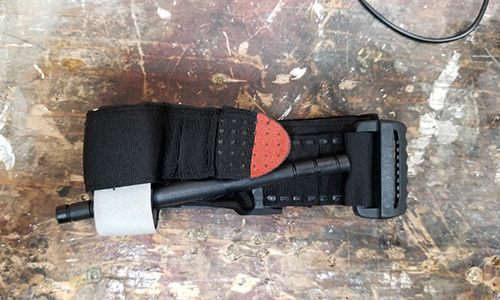
Along with your tourniquet, include a felt pen for writing down when you placed the tourniquet.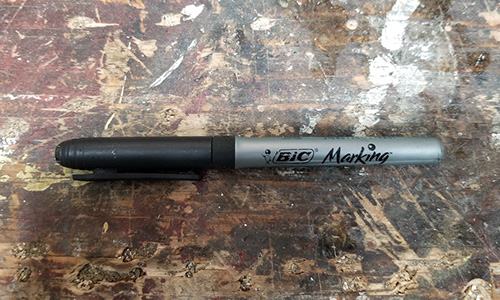
EMT Shears
Cutting away clothing will be one of your first steps in treating a gunshot wound, and EMT shears will make short work of cutting through all manner of clothing.
Don’t cheap out on this item, and it needs to work well. I like to keep my shears on the outside of the pouch for immediate access.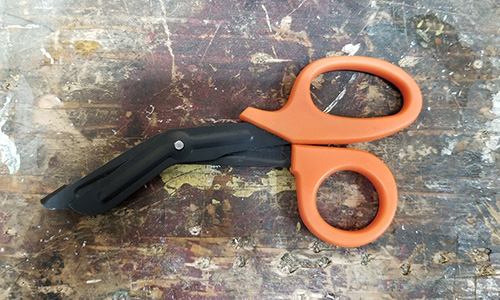
Pressure Dressings
Direct pressure is our go-to method for bleeding control, and having at minimum two pressure dressings is vital in any gunshot wound kit; pack one dressing for both the entry and exit wounds.
Again, many options are available, such as combat dressings, Israeli combat bandages, or civilian pressure dressings.
Related: How to Make Cabbage Bandages to Treat Inflammation and Joint Pain
As long as they will apply pressure to the wound, any of these are good options.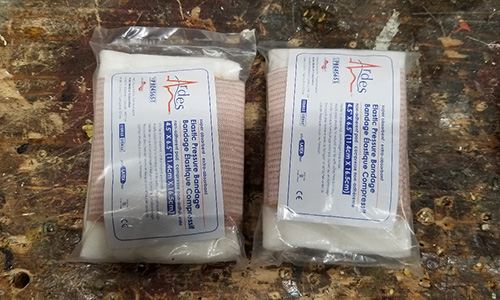
Chest Seals
Chest seals or occlusive dressings are for sucking chest wounds, and while you can purchase them, they are easily improvised using tape and some plastic.
I like to carry a small roll of tape and plan to use either the plastic wrapping for the pressure dressings or the zip lock bag to create a chest seal.
To improvise a chest seal, place plastic over the sucking chest wound and tape all four sides creating a seal. Some schools of thought say only to tape three sides, which will make an improvised one-way valve, and you should seek training before planning on using chest seals.
Gauze
Wound packing is something that you may need to do depending upon the size of the wound. You’ll need to carry an assortment of gauze pads or some compressed gauze.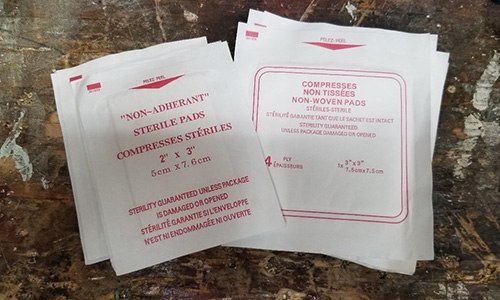
Gloves
You need to protect yourself, and that starts with wearing non-latex gloves. I like to have at least two pairs in any of my kits.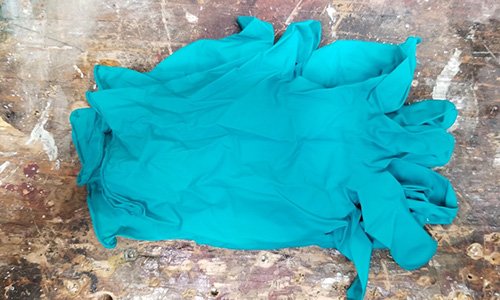
Emergency Blanket
Once you’ve dealt with any bleeding, you need to think about treating for shock since it is not practical to carry a full-sized blanket on your battle belt or plate carrier.
A foil emergency blanket will be the next best thing.
Other Items to Think About
– Decompression needles are an item that has become popular to include in gunshot wound kits but requires advanced training to use.
– Nasopharyngeal airways find their way into many people’s kits and are often recommended to be included, but these require training to use, and you should not include one unless you are trained.
– In the era of COVID-19, we need to think about packing some surgical face masks in with our kit. There needs to be at least three, one for the casualty, one for you, and one for anyone who is assisting you.
– I include a flashlight in every first aid kit that I build. Since we never know what time of day an emergency will strike, it is always a good idea to have a light source. If you can find a headlamp that will fit in the pouch, that would be a better option than a handheld flashlight.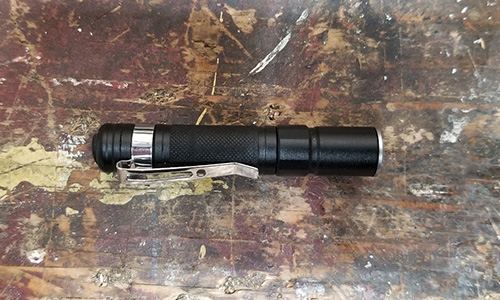 – A CPR mask is something that I do not include in this kit because I design this style of kit for bleeding control and usually keep a pocket mask in my main first aid kit. You may want to include a CPR mask if you carry this kit independent of any other first aid equipment.
– A CPR mask is something that I do not include in this kit because I design this style of kit for bleeding control and usually keep a pocket mask in my main first aid kit. You may want to include a CPR mask if you carry this kit independent of any other first aid equipment.
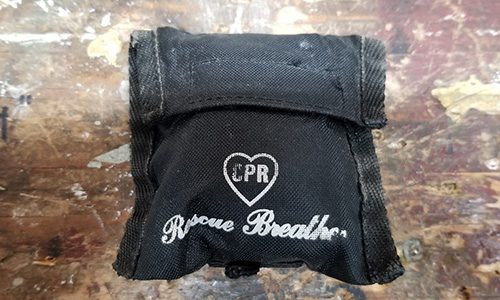
SHTF doesn’t have to be an apocalyptic scenario. With the rise in active shooter incidents worldwide and the threats of violence through rioting and other civil unrest, it is prudent to carry a DIY bullet wound kit as a part of your EDC.
A kit like this is not limited to simply treating gunshot wounds; it will be an effective kit for treating any major bleeding.
You may also like:
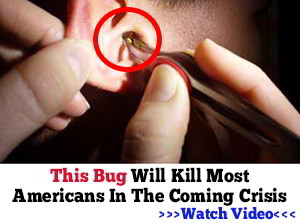 How To Make A Gluten-free Emergency Kit
How To Make A Gluten-free Emergency Kit
How to Manage A Gunshot or Stab Outside the Operating Theatre (Video)

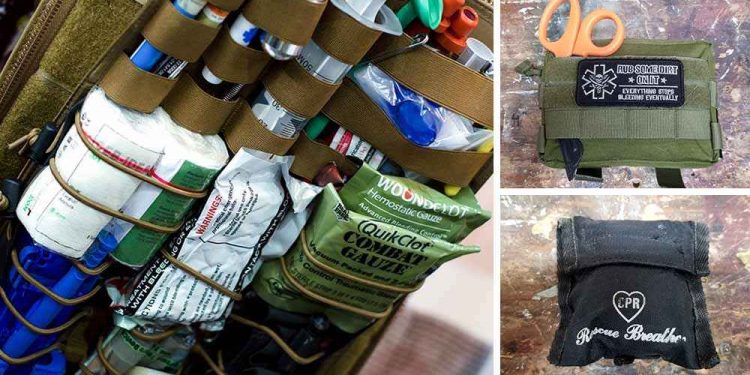













Is there a DIY Gun Shot Wound Kit already made up that is available like the one in this article that can be purchased?
Check out refugemedical.com.
Which child should I sell to buy any of that overpriced stuff?
This is probably the most comprehensive and cost-effective kit you can buy on Amazon. I went to professional first-responder CPR training and this is the kit that matches everything we were taught to have.
https://www.amazon.com/dp/B08DRVHQZD?_encoding=UTF8&psc=1&linkCode=ll1&tag=fsbastore-20&linkId=cee2d58a9abf4efbab80d43fc5112aa9&language=en_US&ref_=as_li_ss_tl
I went on line and looked at the kit that Jay D. posted. It looks pretty complete. The chest seal included in the kit is a dual seal. When hit by a rifle round, many times it is a through and through wound and the back needs to be sealed as well as the front to prevent collapse of the lung.
I don’t know if you would save any money buying a small bag and the individual pieces. Perhaps you might save 20% but how much is your time worth? If I wanted to try to save bucks, I would list the pieces in the product description and then search on the internet to see how much they cost individually.
Go to http://www.tactical-medicine.com Really everything you need is there!
Absolutely. Google “Gunshot Wound Kits” or “Trauma Wound Kits”. A personal one may run you from $40-$70. I also found that “Downed Officer” kits are also usually cheaper and contain the same things. I throw a couple extra tourniquets, prep pads, tampons, and whatever else I may expect to need in mine!
SHTF: realistically without additional support (hospital) what is the probability of effectively treating GSW. You need hemodynamic support, ability to clean and repair wound channel and prevention of infection just to give a very broad overview. If there is a short term more localized SHTF treat the wound. If the SHTF is long term and wide spread your either need to be able to treat as listed above or make hard choice associated with the viability of the GSW victim. Only way to make certain you win a gun fight is avoid a gun fight.
I am afraid in an EOTW situation many injuries which are reasonably simple to treat will become fatal. While a compound fracture today is a serious but generally easily treated injury in a chaotic situation getting competent medical care may be impossible. While compound fractures can be treated by a non-medical person, the chances of sepsis and loss of limb and death are greatly enhanced. The same with GSWs. A gut shot is treatable by competent medical personnel in a sterile setting. Aside from externally stopping the bleeding, further treatment such as lavage would necessitate a laparotomy which I am certain not many of us are prepared to undertake. Lavage of the intestinal cavity is necessary to prevent infection from spilled bowel contents. A personal friend took a position from private practice urology to become head of the urology department of the local county hospital. He told me shortly after assuming the position that it had presented many new challenges that he hadn’t encountered in private practice. For instance, just the night before he had to repair a knife wound to the bladder, something he had not done in 20 years of private practice. He had surgically repaired incisions that he had made to bladders but the knife wound was significantly different from a carefully drawn surgical incision designed to be as minimal as possible whereas the knife wound was deliberately as severe and damaging as possible.
@ LCC:
While I agree to a point, in an EOTW, you must do what you can. If the person is going to die without ANY intervention, doing something is better than doing nothing.
There are many herbal plants that can do what is needed: there are plants that can be mashed up and inserted into the wound to
Help stop bleeding, (Cayenne pepper, yarrow are two…powder in the wound)
Help with sepsis and infection, (Oregano, Angelica, Astragalus) and
Help with healing broken bones. (Boneset and comfrey..be careful, boneset can heal so quickly that internal damage may be locked in before it heals…, nettle, these three as tea, and powdered in the wound…again, be sure infection has been taken care of first.
There are most likely many others, if searched for, that will aid in healing bad wounds and keeping infection at bay.
I’ve always thought that a good “training” method for Army medics & Navy Corpsmen would be to spend Fri & Sat nights at a big city ER Room. They would experience in “real time” what to expect and how to respond. It’s one thing to watch a video & another to be there for real.
An advancement in hemodynamic stabilization is ‘quick clot’ type dressings. The ability to shunt / stem the flow of bleeding has been found to increase vascular recovery by 70 % ( US Combat comorbidity studies, 2009-2019). Good article – heat advice BE TRAINED ! Thx
Your first aid kit should include hemostatic dressings. The older technique was to pour the hemostatic material into the wound to be cleaned out in a trauma center. I understand newer technique is to apply dressings containing hemostatic material to the wound site, not to pour that material into the wound itself. Understand that I am a layman and not qualified to give medical advice, merely repeating what I have read written by folks who purportedly are qualified to give medical advice.
You can even buy from Amazon, of course where else? Hemostatic bandages to apply to smaller wounds. This is a nice breakthrough for folks like me who take blood thinners which encourage bleeding to stop minor cuts from bleeding an annoyingly long time. Trying to stop a razor nick with toilet paper when on blood thinners is a losing battle. The small hemostatic bandaids stop the bleeding quickly and one can remove the bandaid after a short period of time without starting up the torrent of blood that flows from just a minor nick on the face.
Back in the 1970s, medics attached to Marine Corp units carried tampons to plug holes and stop bleeding. As a squad leader, my husband would also carry a few, just in case. They would put pressure on blood vessels within the wound.
The hemostatic dressings mentioned by LCC would be a more modern treatment.
Most gunshot wounds are self inflicted accident of some gun happy idiot accidently shooting himself in the leg.
Lisa
What a great comment here. Have you nothing to add except negativity?
The FBI tracks such things as GSW and their figures indicate that most GSW are inflicted by criminals on other criminals. Followed in place by criminals getting shot by law enforcement officers while said criminals are aggressively resisting arrest for crimes. Or, as Lisa would say, lawfully redistributing the wealth from the haves to the have-nots. That is until she is carjacked and pistol whipped by one of the underprivileged.
Give us your statistics and the credible sources so that we can review them ourselves please.
I always thought Armour plating was a waste of resources because getting shot elsewhere will be fatal too unless you get to a hospital for treatment. How many functioning hospitals will there be? A shot to the vitals may be a blessing.
If all possible, avoid a gun battle and protect your soul.
Valid point
Spike
Agree to a point but the same argument can be made about seatbelts or airbags. You dont need them until you need them.
I have no desire to get into a raging gunfight with anyone. BUT in the extremely unlikely event I need to, I would rather have my FRA on. I know nothing will make me bullet proof except not getting shot at but sometimes we do not get to chose that.
Everyone should keep in mind that you don’t necessarily need a doctor these days to fix you up. An LPN, RN or even a Veterinarian is better than doing it yourself. They use the same instruments and bandages on our pets.
Spike: The advantage of body armor is that it helps prevent instantly fatal or almost instantly fatal wounds to the torso. It doesn’t prevent any injury. Getting hit in the plate with a high velocity rifle round will still put you on the ground and you will have an impressive bruise shortly plus the next day you will be stiff and sore. Is that better than being dead? Only you can decide for yourself. Even though I am close to the end of this lifetime, I don’t want to be hurried along by some evil jerk. I would rather be stiff and sore the next day than stiff and dead the next day.
You are correct, the best way to avoid getting shot is to avoid getting into gunfights. But as Consco pointed out, sometimes you just don’t have the option. I submit that in a world without rule of law, folks who get their jollies killing people in the nastiest ways will feel free to exercise the lowest of their evilness.
I have long maintained that ordinary folks can’t conceive of the evilness that exists in some humanoids. I call them humanoids because they have the cunning of human beings but are utterly lacking in any of the gentler feelings of mankind. It doesn’t surprise me that some cops lack feelings. It is the way they cope with the nastiness they encounter almost daily on some beats in major cities. Have you ever looked at a child that has been tortured by its parents? I thought not. You probably have not even seen photographs of such children. Have you ever listened to the tape recording made of a young woman being raped and tortured, pleading with her torturers not to kill her? I thought not. My colleague who had to listen to that tape said in all the evidence he had attended to that was the first time he ever cried listening to the final words of that young woman. Just two quick examples of the depravity of truly evil persons. And incidents of torturing your own child to its death are commonplace in a world with rule of law. Now contemplate that all the punitive aspects of civilization are gone. Do you think that evil will disappear in such circumstance and we all will be sitting around the campfire singing kumbayah? You need to read Bercovic’s book about life in Sarajevo during the troubles in that benighted city. That will give you a realistic look at life without rule of law.
Wow, imagine that an uninformed idiot with a keyboard commented right above me!
Sorry, Spike that was not meant for you, the one above you.
Then it seems everyone is commenting on Lisa’s remarks? Maybe she needs to read the homicide reports for Chicago over a single weekend…may change her mind.
In reply to Earp: Looks like the super full moon has brought out the trolls. If you cannot add some informative information, please refrain from personal attacks. It is one thing to point out a possible error in a posting but snarky comments from behind a pseudonym are the mark of a coward in my opinion for whatever that is worth.
how is this DIY if it’s all retail sold products? I was expecting to see what you could use if you didn’t have an IFAK or if all your medical components were already used up.
I guess if you bought a pouch and picked the components yourself…. but if you need this article for that then just buy an already built kit and take a Stop the Bleed class at a minimum. Look at kits from Bear Independent, Blue Force Gear, and Dark Angel Medical has a 20% off sale this month.
Who provides sales for DIY Gunshot Wounds?
Having worked in an ER as a nurse the last thing I would apply is an tourniquet. The goal is to stop blood loss not cut off circulation to a limb. A far better way to control bleeding is to apply a pressure dressing then apply an extra large blood pressure cuff. Pump it up enough to stop the blood loss. Feel for a distal pulse on the limb and if the pulse is missing bleed some of the pressure off. Try and find a compromise where there is a distal pulse and no bleeding. If it comes down to it and you can’t the stop bleeding and maintain the pulse the cuff can be used as a tourniquet. There will be less tissue damage using a cuff.
Larry, I am afraid you have not kept up with the times. No lesser body than the medical arm of the U.S. Armed Forces has decided that applying a tourniquet is much preferable to bleeding to death and in the exigencies of a EOTW situation, the “ideal” method is not usually available. For example, typically medical advice is to not use a men’s leather belt as it is too narrow and applies too much pressure to the tissue underneath it. That said, current first aid manuals go on to say that if that is all you have, use it. It is better to lose a limb than lose a life. That is why every member of the U.S. Armed Forces now carries a tourniquet on his person to be used in the event of an emergency.
I worked in a Level 1 trauma center as a nurse for many years. I have realized that in a SHTF situation, with the possibility of losing managed health care in hospitals and doctors offices, I will end up the local healer for my area. Since I had to retire due to a severe back injury, I don’t have funding to load up on medical supplies. I’m pretty good at improvising, so I hope it will be ok. But hope is a terrible tactical method. At least my knowledge will be useful
Good article. Some thing else that really should be considered is Blood Stop. We used this on the farm all the time growing up. We had cases of it for when we dehorned calves, and you NEED to stop the bleeding. Plus it is soooo much cheaper than these small packets of blood stop. It’s sold all over in farm stores and at the vet but here it is for reference.
https://www.amazon.com/Durvet-Blood-Stop-Powder-16/dp/B000HHLTEM/ref=sr_1_7?dchild=1&gclid=Cj0KCQjwna2FBhDPARIsACAEc_Vsc-SrrzWIww28mD-wpV-sByz76k8Y1nYU7Bhbq2Y1-SFZvxY6cDsaAqm_EALw_wcB&hvadid=409958951740&hvdev=c&hvlocphy=9025259&hvnetw=g&hvqmt=e&hvrand=14875781980331348030&hvtargid=kwd-3592115205&hydadcr=24658_11410762&keywords=blood+stop+powder&qid=1621899841&sr=8-7
$15 for a 16 oz bottle of blood stop and $15.00 for 3″ x 24″ of Quik Clot bandage. The blood stop powder also contains an insect repellant to keep the flies off your wound. Both seem like a good investment to me even if the only wound you suffer is when you chop your leg with the axe while cutting wood for various purposes.
We focused in the article and the discussion about GSWs. You may die of old age before you suffer a GSW but cutting by a variety of objects is a lot more likely. Whacking one’s leg with an axe is a too common experience and always results in an impressive wound. Stabbing oneself with a knife too occurs far more than we would like to think. One might want to obtain a supply of butterfly bandages for those oops occasions where the knife slips and nicely opens up a good sized cut. Unless the wife is handy with a needle and catgut (we all have catgut in our first aid kits, right?) butterfly bandages are going to be the go to product for that nasty knife cut at the base of your thumb. Don’t bother asking me how I know about nasty cuts at the base of one’s thumb and the appropriate products to use in that case. I would mention it is much easier to apply bandages to one hand if one has an assistant standing by to “lend a hand”. It can be done one-handed but two or three hands is so much easier. The end work product looks more professional too.
@ Bill: cayenne pepper or yarrow will do the same for MUCH cheaper!
Just from experience, I would recommend Kotex pads and tampons. they are good leak stoppers and the pads work well for compression dressings.
We have used sanitary napkins on horses with leg cuts, they work well.
Texas: Please do not stuff tampons into deep penetrating wounds. Several EMTs have written in to this site to say that is poor medical advice. All you do when you stuff a tampon into a wound channel is push any contaminating material around the entrance to the channel into the channel and stuff any contaminating material in the channel further into the wound, creating a nice site for the resulting bacterial infection that follows. President Garfield died as a result of the quack doctor probing the wound channel with a dirty finger. Unfortunately, he was shot in the era when the existence of bacteria was still a novel concept and doctors prided themselves on maintaining that their hands were clean because of their professional status. I suppose compared to the average dirt farmer, their hands appeared cleaner but because they didn’t even wash their hands between patients, in all likelihood, their hands were far more contaminated than the typical truck farmer with earth beneath his fingernails.
In an EOTW situation, bacterial infections will be far more prevalent and far more deadly than they are today for a myriad of reasons which I won’t detail here but you can just imagine without antibiotics, what is just a minor injury can easily become a major, limb or even life threatening calamity. We shouldn’t help such possible infection along by stuffing foreign material into wound channels.
Feminine sanitary products are clean but not sterile. Rather than loading up on feminine hygiene products for wound covering and bleeding control, load up on sterile 4×4 pads or larger sterile pads. They are cheaper than feminine hygiene products. They are sterile as long as the wrappings are intact and they work just as effectively in protecting wounds as feminine hygiene products. If you have nothing else, fine, but don’t stock them up in place of medical devices that work and are sterile.
I have seen injuries with significant bleeding, including my own, but most people haven’t. I’ve given first aid to a number of people over the years and can say with any bleeding injury shock from panic is almost as much a threat as shock from blood loss. Having a first aid kit with proper supplies and treating them calmly and correctly is an important part of reassuring them. There were plans a few years back to hang bleeding control kits alongside public AEDs but it seems to have fizzled. In fact I hardly ever see AEDs these days.
I think what Lisa meant is that 60% of gun deaths are suicides. Don’t know the numbers for injuries overall.
The Governor is signing the bill tonight to allow open carry of handguns w/o a permit in Texas. Won’t see a lot of people doing it, but it’s always nice when your Government treats you like a responsible adult.
My husband is on blood thinners. I keep blood stop powder and treated gauze pads also , just in case.
When I was 10 I was hit by a stray 38 special bullet in the weed forearm. Burned at first.. then hurt.. I pulled off my blouse and wrapped the arm as tight as I could as I walked to the hospital where my Dad worked. 5 blocks. I was dripping blood by the time I got there but was luck I didn’t go into shock. God I’d hate to go through that again.
Bullet mushroomed on the bone. Dr cut a wedge of muscle out of my arm to remove it. I still remember that strange sensation of a hard hit them the burning sensation. Good thing I never was squeamish about blood. That may have made the situation worse.
I went on line and copied the FBI website that lists who committed what crimes and how many times but apparently it didn’t get posted. One can go on line and search for FBI crime statistics and see for themselves who shoots whom. I have read and seen figures that tend to support the article that if we eliminated 25 zip codes — not cities, but just zip codes, the rate per 1,000 citizens of homicides would place the U.S. in the bottom of homicides per 1,000 in the world. Judge Holden is correct that the majority of deaths by firearms in the U.S. are suicides. But I don’t think that Lisa was referring to suicides indicated to me by the location of where she said the individuals shot themselves.
I won’t discuss arms availability and suicide as I don’t feel that is a topic for this forum. I will simply state that is a complicated topic but banning firearms is not the answer to the problem of suicide.
LCC
I go on the FBI website as well.
Agree with you about the zip codes as I have looked that up as well.
Amazing how few people really know the truth about crime statistics in our country when all they have to do is look.
Guess it is tough for some to shut off the TV.
ClergyLady you are tougher than I am!!!!
darkangelmedical.com, IFAK’s and training. Purchase a kit for life, if you have to use it, you get a free refill. They also have a youtube channel.
Thanks for the heads up. Wife and I already have 1 each. Just ordered these.
Looks like a great product.
Many products out there now to stop bleeding. endless wars have improved our methods of treatment and in some cases make it easier for a lot of us with some training.
Main Thing
Control Bleeding, Stop infection , Remove bullit
Anti infection aids are best
Time is everything in ER situations and best to keep the spread down
yu can burn the wound if in a survival enviornent to seal and stop infections
but not best
peroxide , rubbing alchol , and clorox bleach
other items is Cleanlyness is criticle
Wash , Rinse, use clean lennons
no dirt, filthy clothing , cleaner the better
again : Back country tactics or urbin city solutions
must apply based on time to medical attention
best solution is : use what ever at your disposal at time , even gun power can be used if needed to burn out the wound and keep infection under control
Obviously “Conflict Avoidance” is the priority to avoid gun shot wounds and the ensuing deadly infections. If successful, then you can focus on critical infection prevention in an extremely highly contagious pathogenic world. I found this info and it confirms ignorance and/or even slight cuts can get you killed when the SHTF.
BACTERIA Pathogens
tuberculosis – an infection of the lungs;
typhoid fever – an infection spread in contaminated water;
diphtheria – an infection spread in contaminated water;
salmonella – spread in sewage, water, raw or under-cooked meat;
Cholera – an infection spread in contaminated food and water;
leprosy – causes damage to the skin and the nervous system;
botulism – deadly bacteria toxin found in damaged cans of food.
PARASITE Pathogens
Blood Fluke – a flatworm that lives in human blood vessels;
Tapeworm – a long worm that lives in the intestines;
Liver Fluke – a flatworm that lives in the liver;
Filarial Worm – a round worm that lives in the lymph nodes;
Brain Eating Amoeba – warm water “swimmer” infections of brain;
Hook Worm – infest soil, small worms that live in intestines;
Pin Worm – a tiny white worm that lives in the intestines.
VIRUS Pathogens
cold – highly contagious and easily spread between humans;
influenza – highly contagious and easily spread between humans;
measles – highly contagious, commonly found in children;
bubonic plague – deadly, spread by rats and fleas;
smallpox – deadly, contagious, easily spread between humans;
viral hemorrhagic fever – deadly, infects multiple organs;
yellow fever – causes high fever and jaundice (yellow skin and eyes);
polio – causes nerve damage leading to paralysis;
HIV/AIDS – destroys the human immune system;
rabies – deadly, zoonotic from various animals, infects the brain;
avian bird flu – zoonotic from birds, infects the lungs;
SARS – corona virus, zoonotic, infects the lungs;
H1N1 Swine flu – zoonotic from pigs, infects the lungs;
ebola – deadly, zoonotic, hemorrhagic infection of multiple organs;
SARS-CoV-2 – mutating corona virus, infects lungs, other organs;
malaria – blood infection spread by worst vector of all: mosquitoes;
zika – blood infection spread by mosquitoes, causes birth defects;
west nile – blood infection spread from birds by mosquitoes;
Dengue – blood infection spread by mosquitoes, bone and joint pain;
Chikungunya – blood infection spread by mosquitoes, joint pain;
Hantavirus – deadly, spread by rodents, long incubation in lungs;
Lassa fever – spread by rodents, long incubation, hemorrhagic fever;
Marburg – spread by bats, causes deadly hemorrhagic fever;
Nipah – spread by bats, causes deadly brain infections.
There are MANY other deadly zoological (spreads from animals to humans) and non-zoological pathogens,
that are not listed above.
Be Smart, Be Safe.